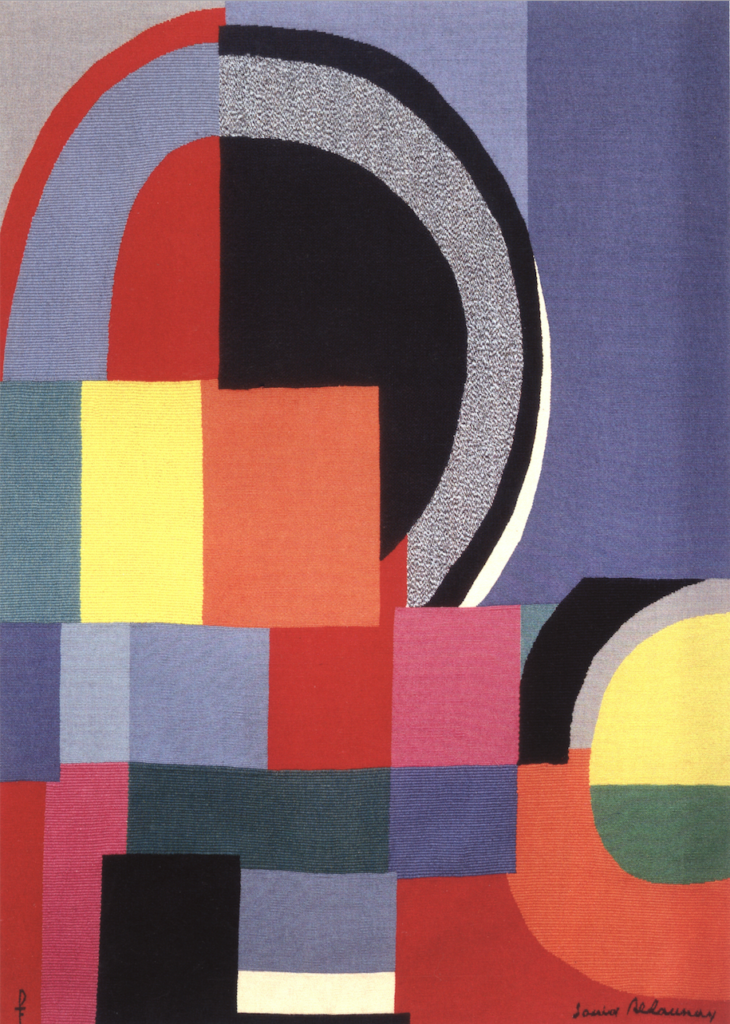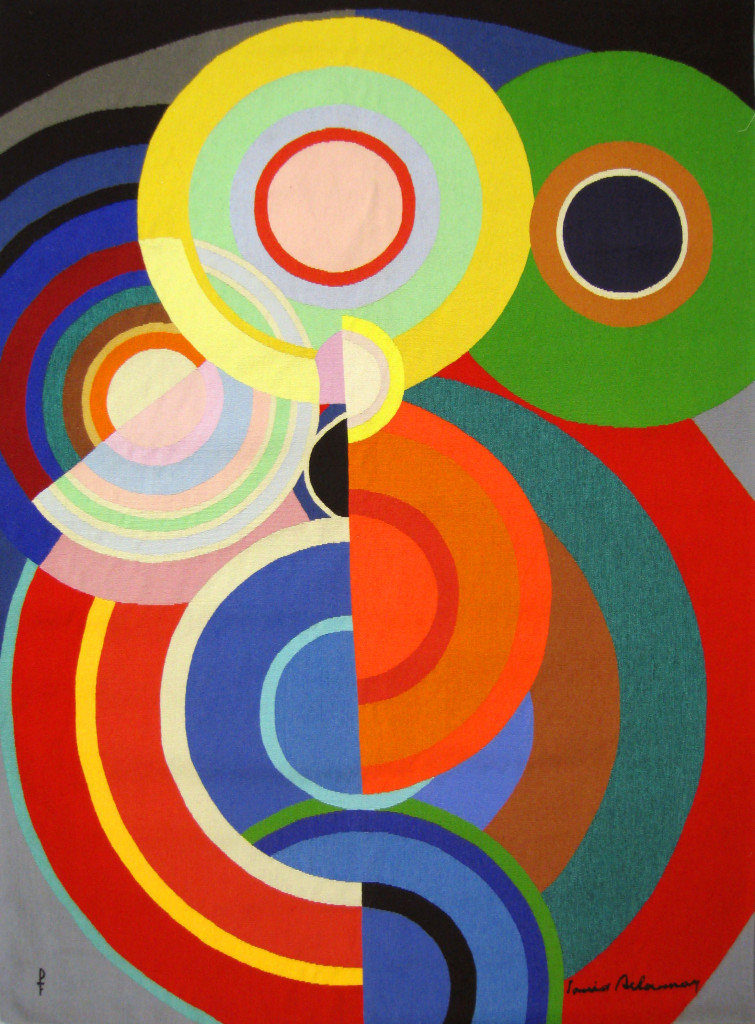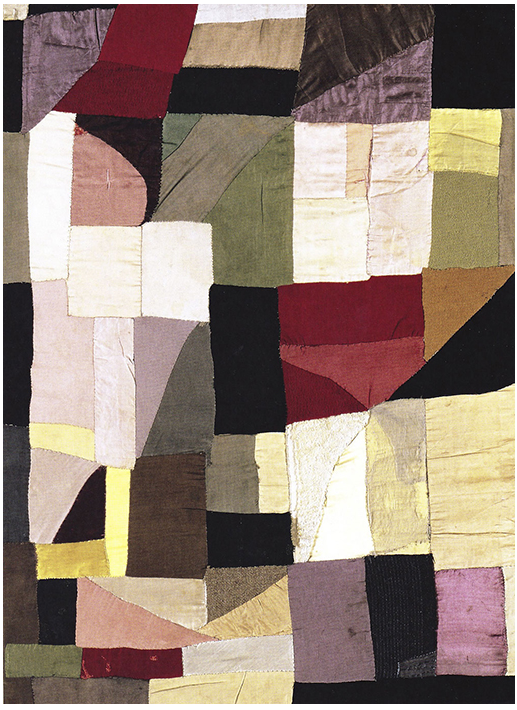Sonia Delaunay
SONIA DELAUNAY (1885-1979) is widely regarded for her work in the visual arts, design and decorative arts. In recent decades, awareness of Sonia’s liberating compositions and projects has introduced many contemporary viewers to her practice.
SONIA DELAUNAY TAPESTRY

Jane Kahan Gallery Collection. Photo Jane Kahan Gallery.

Jane Kahan Gallery Collection. Photo Jane Kahan Gallery.
SONIA DELAUNAY BIOGRAPHY
Sonia Delaunay, born Sonia Stern on November 14, 1885 in Hradyzk in the Russian Empire (modern day Ukraine). At a young age, she moved to St. Petersburg to live with her maternal uncle and his wife. The Terks wanted to support Sonia, and after overcoming her mother’s resistance, they succeeded in adopting Sonia in 1890. Sonia Terk lived a privileged life, traveling Europe with her adoptive parents and attending highly regarded schools. At 18, she attended the Academy of Fine Arts in Karlsruhe, Germany, where she studied until 1905, when she decided to move to Paris.
Once in Paris, Terk enrolled at the Académie de La Palette in Montparnasse. However, unhappy with the critical nature of the classes, she instead preferred to immerse herself in, and learn from, the art in Paris’ galleries. Major influences during this period included the Post-Impressionist art of Vincent Van Gogh, Paul Gauguin, and Henri Rousseau, as well as the Fauvist work of Henri Matisse and Derain. In 1908, Terk married Wilhelm Uhde, the renowned German gallerist and closeted homosexual. The union was thought to be one of convenience for both of them: an escape for Terk from her parents, who wanted her to abandon art and return to Russia, and a cover for Uhde’s true inclinations. Their marriage also, in turn, exposed her to art exhibitions and connections. In 1909, she met Robert Delaunay and made the arrangements to divorce Uhde, and marry Robert the following year. Sonia and Robert’s son was born in 1911, with Sonia’s aunt financially supporting them from St. Petersburg.
Sonia Delaunay created, for her newborn son, a patchwork quilt that is now in the collection of the Musée National d’Art Moderne, Centre Pompidou in Paris.

The quilt’s spontaneous creation and use of geometry and color signify Delaunay’s move towards Cubism, and away from perspective and naturalism. Together with her husband, who was studying color theories at the time, Sonia Delaunay experimented with color and design in a way that she called simultanéisme; simultaneous design, as she described it, occurs when two designs are placed next to each other in order to affect one another. Delaunay’s first large-scale painting, utilizing both color and movement in this way, was Bal Bullier (1912-13). Guillaume Apollinaire, a friend of the couple, coined the term “Orphism” to describe their style of Cubism, which is based in that artistic style, but aimed for pure abstraction and lyric, colorful compositions than that of regular cubism. Orphism is noted for its particularly vibrant colors.
In 1914, the Delaunays were visiting friends in Madrid when World War I began; rather than return to France, they stayed in Spain, and then moved to Portugal the following year. The Russian Revolution ended the financial support from Sonia Delaunay’s family, and sent the couple in search of steady income. In 1917, they worked with Sergei Diaghilev in Madrid on his production of Cleopatra: Sonia designed the costumes and Robert designed the stage. She also decorated the Petit Casino, a nightclub in Madrid, and founded Casa Sonia, where she sold her interior decoration and fashion designs.
In 1920, Delaunay visited Paris twice looking for business opportunities in fashion, and extended an offer to collaborate with Paul Poiret. Poiret declined, accusing her of copying his designs and of being married to a French deserter. Later that year, the Galerie der Sturm in Berlin showed works from the Delaunays’ Portuguese period. The Delaunay family permanently returned to Paris in 1921, and solved their financial troubles by selling Henri Rousseau’s La Charmeuse de serpents (The Snake Charmer) to Jacques Doucet.
In 1923, Delaunay was commissioned by a manufacturer in Lyon to create fifty geometric and boldly colored fabric designs. She then started her own business and trademarked simultané. Delaunay’s fashion career continued to flourish as she designed for plays, films, and opened a studio with Jacques Heim. She also helped her husband with his commission for the 1937 World Fair in Paris, where they decorated two pavilions. Her career continued to flourish as she worked in a variety of mediums: paintings and gouaches of lyrical abstract color rhythms, as well as lithographs, Aubusson tapestries, and textiles. After World War II, Delaunay served as a board member of the Salon des Réalités Nouvelles for many years.
In 1957, she was named an officer of the French Legion of Honor.
In 1964, she became the first living female artist to have a retrospective exhibition at the Louvre.
She continued working steadily and diligently until her death on December 5th, 1979. She was buried in Gambais, next to her husband. Today, her work can be found in the collections of major museums throughout the world, including the Centre Pompidou in Paris, the Art Institute of Chicago, the Museum of Modern Art in New York, and the Metropolitan Museum of Art. Sonia Delaunay continues to be recognized and celebrated throughout the art world for her major contributions to the evolution of abstract art. In 2014, the Musée National d’Art Moderne in Paris opened a blockbuster retrospective of her works to much critical acclaim; the exhibition later traveled to the Tate Modern in London.
